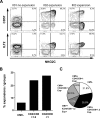Independent skewing of the T cell and NK cell compartments associated with cytomegalovirus infection suggests division of labor between innate and adaptive immunity
- PMID: 24065293
- PMCID: PMC4039248
- DOI: 10.1007/s11357-013-9587-y
Independent skewing of the T cell and NK cell compartments associated with cytomegalovirus infection suggests division of labor between innate and adaptive immunity
Abstract
Cytomegalovirus (CMV) infection induces profound changes in different subsets of the cellular immune system. We have previously identified an immune risk profile (IRP) where CMV-associated changes in the T cell compartment, defined as a CD4/CD8 ratio < 1, are associated with increased mortality in elderly people. Since natural killer (NK) cells have an important role in the defense against viral infections, we examined whether the expansion of CD8 + T cells seen in individuals with CD4/CD8 ratio < 1 is coupled to a parallel skewing of the NK cell compartment. A number of 151 subjects were examined with CMV serology and a flow cytometry panel for assessment of T cell and NK cell subsets. CMV-seropositive individuals had higher frequencies of CD57 + and NKG2C + NK cells and lower frequencies of NKG2A + NK cells, in line with a more differentiated NK cell compartment. Intriguingly, however, there was no correlation between CD4/CD8 ratio and NK cell repertoires among CMV-seropositive donors, despite the profound skewing of the T cell compartment in the group with CD4/CD8 ratio < 1. Conversely, donors with profound expansion of NK cells, defined as NKG2C + NK cells with high expression of CD57 and ILT-2, did not display more common changes in their T cell repertoire, suggesting that NK cell expansion is independent of the T cell-defined IRP. Altogether, these results indicate that the effect of CMV on CD8 T cells and NK cells is largely nonoverlapping and independent.
Figures





Similar articles
-
A longitudinal study of the stability, variability, and interdependencies among late-differentiated T and NK cell subsets in older adults.Exp Gerontol. 2019 Jul 1;121:46-54. doi: 10.1016/j.exger.2019.03.006. Epub 2019 Mar 15. Exp Gerontol. 2019. PMID: 30885717 Free PMC article.
-
NKG2C(+)CD57(+) Natural Killer Cell Expansion Parallels Cytomegalovirus-Specific CD8(+) T Cell Evolution towards Senescence.J Immunol Res. 2016;2016:7470124. doi: 10.1155/2016/7470124. Epub 2016 May 29. J Immunol Res. 2016. PMID: 27314055 Free PMC article.
-
Regulation of Adaptive NK Cells and CD8 T Cells by HLA-C Correlates with Allogeneic Hematopoietic Cell Transplantation and with Cytomegalovirus Reactivation.J Immunol. 2015 Nov 1;195(9):4524-36. doi: 10.4049/jimmunol.1401990. Epub 2015 Sep 28. J Immunol. 2015. PMID: 26416275 Free PMC article.
-
About Training and Memory: NK-Cell Adaptation to Viral Infections.Adv Immunol. 2017;133:171-207. doi: 10.1016/bs.ai.2016.10.001. Epub 2016 Nov 30. Adv Immunol. 2017. PMID: 28215279 Review.
-
The CD94/NKG2C+ NK-cell subset on the edge of innate and adaptive immunity to human cytomegalovirus infection.Semin Immunol. 2014 Apr;26(2):145-51. doi: 10.1016/j.smim.2014.03.002. Epub 2014 Mar 22. Semin Immunol. 2014. PMID: 24666761 Review.
Cited by
-
Rapid NK cell differentiation in a population with near-universal human cytomegalovirus infection is attenuated by NKG2C deletions.Blood. 2014 Oct 2;124(14):2213-22. doi: 10.1182/blood-2014-05-576124. Epub 2014 Aug 22. Blood. 2014. PMID: 25150297 Free PMC article.
-
Dual Role of Natural Killer Cells on Graft Rejection and Control of Cytomegalovirus Infection in Renal Transplantation.Front Immunol. 2017 Feb 16;8:166. doi: 10.3389/fimmu.2017.00166. eCollection 2017. Front Immunol. 2017. PMID: 28261220 Free PMC article. Review.
-
Surface NKG2C Identifies Differentiated αβT-Cell Clones Expanded in Peripheral Blood.Front Immunol. 2021 Feb 16;11:613882. doi: 10.3389/fimmu.2020.613882. eCollection 2020. Front Immunol. 2021. PMID: 33664730 Free PMC article.
-
Alterations of the NK cell pool in HIV/HCV co-infection.PLoS One. 2017 Apr 5;12(4):e0174465. doi: 10.1371/journal.pone.0174465. eCollection 2017. PLoS One. 2017. PMID: 28380039 Free PMC article.
-
A longitudinal study of the stability, variability, and interdependencies among late-differentiated T and NK cell subsets in older adults.Exp Gerontol. 2019 Jul 1;121:46-54. doi: 10.1016/j.exger.2019.03.006. Epub 2019 Mar 15. Exp Gerontol. 2019. PMID: 30885717 Free PMC article.
References
-
- Beziat V, Dalgard O, Asselah T, Halfon P, Bedossa P, Boudifa A, Hervier B, Theodorou I, Martinot M, Debre P, Bjorkstrom NK, Malmberg KJ, Marcellin P, Vieillard V. CMV drives clonal expansion of NKG2C + NK cells expressing self-specific KIRs in chronic hepatitis patients. Eur J Immunol. 2012;42(2):447–457. doi: 10.1002/eji.201141826. - DOI - PubMed
-
- Beziat V, Liu L, Malmberg JA, Ivarsson MA, Sohlberg E, Bjorklund AT, Retiere C, Sverremark-Ekstrom E, Traherne J, Ljungman P, Schaffer M, Price DA, Trowsdale J, Michaelsson J, Ljunggren HG, Malmberg KJ. NK cell responses to cytomegalovirus infection lead to stable imprints in the human KIR repertoire and involve activating KIRs. Blood. 2013;121(14):2678–2688. doi: 10.1182/blood-2012-10-459545. - DOI - PMC - PubMed
-
- Bjorkstrom NK, Lindgren T, Stoltz M, Fauriat C, Braun M, Evander M, Michaelsson J, Malmberg KJ, Klingstrom J, Ahlm C, Ljunggren HG. Rapid expansion and long-term persistence of elevated NK cell numbers in humans infected with hantavirus. J Exp Med. 2011;208(1):13–21. doi: 10.1084/jem.20100762. - DOI - PMC - PubMed
Publication types
MeSH terms
Substances
LinkOut - more resources
Full Text Sources
Other Literature Sources
Medical
Research Materials
